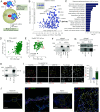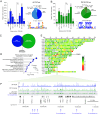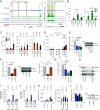p63 and ZNF148 cooperate to regulate head and neck squamous cell carcinoma
- PMID: 40623191
- PMCID: PMC12280952
- DOI: 10.1073/pnas.2500579122
p63 and ZNF148 cooperate to regulate head and neck squamous cell carcinoma
Abstract
Head and neck squamous cell carcinoma (HNSCC) is a common and aggressive malignancy. While significant advances have been made in the management of low-grade cancer, treatment of advanced HNSCC remains challenging. Here, we used a proteomic approach to find binding partners of the oncogene p63, the most frequently amplified transcription factor in HNSCC. We identified a zinc finger protein, ZNF148, which is coexpressed and physically binds p63 in carcinoma cells. Genome occupancy analyses identified a functional transcribed enhancer-derived RNA (eRNA) upstream of the CCND1 gene occupied by both factors. Mechanistically, p63 and ZNF148 control transcription of this eRNA, leading to overexpression of cyclin D1 to reinforce tumor cell proliferation. Importantly, this axis is specific for cancer cells and remains inactive in normal epithelial cells. The expression levels of these factors and the eRNA are positively correlated in cancer and associated with advanced stage and metastasis. Collectively, our data reveal a molecular pathway controlling HNSCC progression and identify potential selective targets for cancer treatment.
Keywords: CCND1; ZNF148; cancer; p63; transcription.
Conflict of interest statement
Competing interests statement:The authors declare no competing interest.
Figures






References
-
- Maghami E., et al. , Diagnosis and management of squamous cell carcinoma of unknown primary in the head and neck: ASCO guideline. J. Clin. Oncol. 38, 2570–2596 (2020). - PubMed
-
- Mody M. D., Rocco J. W., Yom S. S., Haddad R. I., Saba N. F., Head and neck cancer. Lancet 398, 2289–2299 (2021). - PubMed
-
- Gupta G. P., Massagué J., Cancer metastasis: Building a framework. Cell 127, 679–95 (2006). - PubMed
MeSH terms
Substances
Grants and funding
- ID22206/Fondazione AIRC per la ricerca sul cancro ETS (AIRC)
- ID27366/Fondazione AIRC per la ricerca sul cancro ETS (AIRC)
- RF-2019-12368888/Italy Ministry of Health | Agenzia Italiana del Farmaco, Ministero della Salute (AIFA)
- PNRR-MAD-2022-12375755/Italy Ministry of Health | Agenzia Italiana del Farmaco, Ministero della Salute (AIFA)
LinkOut - more resources
Full Text Sources
Medical
Research Materials

